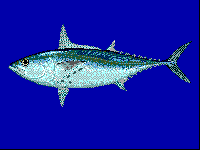 The little tunny (Euthynnus alletteratus) is the most common tuna in the Atlantic Ocean. It is found in warm temperate and tropical waters of the Atlantic and the Mediterranean; in the western Atlantic, it ranges from Brazil to the New England states. It is found regularly in offshore and inshore waters, and is classified as a highly migratory species by UNCLOS. Occurring in large schools and weighing up to 36 pounds, it is the smallest member of the tuna Scombridae family, and is one of the finest small game-fish in the Atlantic. Commonly called false albacore or little tuna, it resembles the Atlantic bonito, skipjack tuna and species of mackerel. It is best identified by the dark spots appearing between its pectoral and ventral fins and “worm-like” markings on its back. Commercially, the fish is used as bait for sharks and marlin due to its high oil content and hook retention. It is sought after as a sport fish due to its line stripping 40 miles per hour (64 km/h) runs and hard fighting ability when hooked. By trolling with lures near reefs, it can be caught on hook and line. The little tunny is small in body size compared to other tuna species. It has a compact and stream-lined body built to facilitate bursts of speed as well as endurance while swimming. Its torpedo-shaped, robust body is made for powerful swimming. It has a large mouth with rigid jaws and a slightly protruding lower jaw, with a single row of small, inwardly curved, cone-shaped teeth on the palatines. Teeth are absent on the vomer, the small bone in the roof of the mouth, and the tongue has two longitudinal ridges. The snout is shorter than the rest of the head. The coloration of the little tunny is typically metallic blue or blue-green with dark wavy stripes above the lateral line. These “worm-like” lines are within a well marked border that never extends farther forward than the middle of the first dorsal fin. The belly is bright white with 3–7 dark, fingerprint-like spots around the pectoral and pelvic fins. The little tunny is commonly confused with the Atlantic bonito because of coloration, but the two fish differ in their color patterns and overall body size. Little tunny reach a maximum weight of 12 kilograms (26 lb) in the Mediterranean, and averages about 7 kilograms (15 lb) through its entire range. The maximum fork length (distance from the tip of the snout to the fork of the tail) of the little tunny in the Mediterranean is about 100 centimetres (39 in) and in the Atlantic is about a 90 centimetres (35 in). Average fork length for an adult fish throughout the entire range is about 85 centimetres (33 in) . Some little tunnies may reach the length of 40 inches (100 cm) or more, but most commonly they are around 25 inches (64 cm). The largest little tunny on record is 48 inches (120 cm) and 36.5 pounds (17 kg).
The little tunny (Euthynnus alletteratus) is the most common tuna in the Atlantic Ocean. It is found in warm temperate and tropical waters of the Atlantic and the Mediterranean; in the western Atlantic, it ranges from Brazil to the New England states. It is found regularly in offshore and inshore waters, and is classified as a highly migratory species by UNCLOS. Occurring in large schools and weighing up to 36 pounds, it is the smallest member of the tuna Scombridae family, and is one of the finest small game-fish in the Atlantic. Commonly called false albacore or little tuna, it resembles the Atlantic bonito, skipjack tuna and species of mackerel. It is best identified by the dark spots appearing between its pectoral and ventral fins and “worm-like” markings on its back. Commercially, the fish is used as bait for sharks and marlin due to its high oil content and hook retention. It is sought after as a sport fish due to its line stripping 40 miles per hour (64 km/h) runs and hard fighting ability when hooked. By trolling with lures near reefs, it can be caught on hook and line. The little tunny is small in body size compared to other tuna species. It has a compact and stream-lined body built to facilitate bursts of speed as well as endurance while swimming. Its torpedo-shaped, robust body is made for powerful swimming. It has a large mouth with rigid jaws and a slightly protruding lower jaw, with a single row of small, inwardly curved, cone-shaped teeth on the palatines. Teeth are absent on the vomer, the small bone in the roof of the mouth, and the tongue has two longitudinal ridges. The snout is shorter than the rest of the head. The coloration of the little tunny is typically metallic blue or blue-green with dark wavy stripes above the lateral line. These “worm-like” lines are within a well marked border that never extends farther forward than the middle of the first dorsal fin. The belly is bright white with 3–7 dark, fingerprint-like spots around the pectoral and pelvic fins. The little tunny is commonly confused with the Atlantic bonito because of coloration, but the two fish differ in their color patterns and overall body size. Little tunny reach a maximum weight of 12 kilograms (26 lb) in the Mediterranean, and averages about 7 kilograms (15 lb) through its entire range. The maximum fork length (distance from the tip of the snout to the fork of the tail) of the little tunny in the Mediterranean is about 100 centimetres (39 in) and in the Atlantic is about a 90 centimetres (35 in). Average fork length for an adult fish throughout the entire range is about 85 centimetres (33 in) . Some little tunnies may reach the length of 40 inches (100 cm) or more, but most commonly they are around 25 inches (64 cm). The largest little tunny on record is 48 inches (120 cm) and 36.5 pounds (17 kg).
